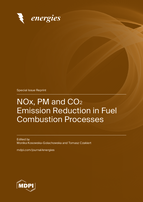NOx, PM and CO2 Emission Reduction in Fuel Combustion Processes
A special issue of Energies (ISSN 1996-1073). This special issue belongs to the section "I2: Energy and Combustion Science".
Deadline for manuscript submissions: closed (31 May 2023) | Viewed by 17398
Special Issue Editors
Interests: combustion; fluidized bed technologies; oxy-fuel combustion; pollutant emissions; biomass; alternative fuels
Special Issues, Collections and Topics in MDPI journals
Interests: conventional power engineering; advanced energy technologies; fluidized bed technologies; oxy-fuel combustion; chemical looping combustion
Special Issues, Collections and Topics in MDPI journals
Special Issue Information
Dear Colleagues,
Nowadays, fossil fuels are still the main source of primary energy in power generation, transport, and industry in general. Therefore, issues regarding environmental protection, and in particular air protection, are of great importance, and hence they have become a key part of global policies respected by most developed countries. The current Special Issue of the Energies journal deals with various methods and reduction technologies targeting pollutant emissions, especially NOx, CO2, and particulate matter, that associate with different fuel combustion processes. Although the topic is focused mainly on conventional hydrocarbon fuels, it is open to biofuels and other alternative fuels as well.
To keep track of the topical achievements made in this field, this Special Issue, entitled NOx, PM, and CO2 Emission Reduction in Fuel Combustion Processes (IF: 3.004), covers original research and studies related to the title topic, including, but not limited to: fundamental research and studies, pilot-plant investigations, operational experiences, new concepts, computer modelling and simulations, as well as techno-economic assessments.
Thereby, we kindly invite you to submit your work to this Special Issue. We look forward to receiving your original research and studies.
Dr. Monika Kosowska-Golachowska
Prof. Dr. Tomasz Czakiert
Guest Editors
Manuscript Submission Information
Manuscripts should be submitted online at www.mdpi.com by registering and logging in to this website. Once you are registered, click here to go to the submission form. Manuscripts can be submitted until the deadline. All submissions that pass pre-check are peer-reviewed. Accepted papers will be published continuously in the journal (as soon as accepted) and will be listed together on the special issue website. Research articles, review articles as well as short communications are invited. For planned papers, a title and short abstract (about 100 words) can be sent to the Editorial Office for announcement on this website.
Submitted manuscripts should not have been published previously, nor be under consideration for publication elsewhere (except conference proceedings papers). All manuscripts are thoroughly refereed through a single-blind peer-review process. A guide for authors and other relevant information for submission of manuscripts is available on the Instructions for Authors page. Energies is an international peer-reviewed open access semimonthly journal published by MDPI.
Please visit the Instructions for Authors page before submitting a manuscript. The Article Processing Charge (APC) for publication in this open access journal is 2600 CHF (Swiss Francs). Submitted papers should be well formatted and use good English. Authors may use MDPI's English editing service prior to publication or during author revisions.
Keywords
- pollutant emissions
- emission reduction technologies
- NOx, PM and CO2
- CO2 capture
- combustion
- co-combustion
- oxy-fuel combustion
- fossil fuel
- biomass
- biofuel
- alternative fuel
- computer modelling and simulations
- techno-economic assessments







